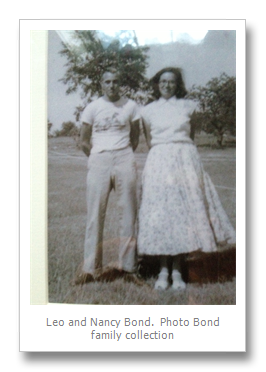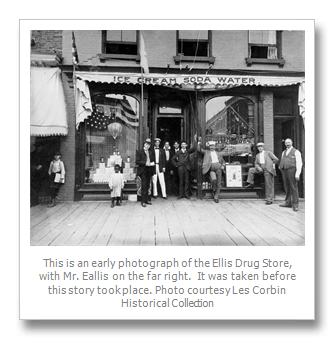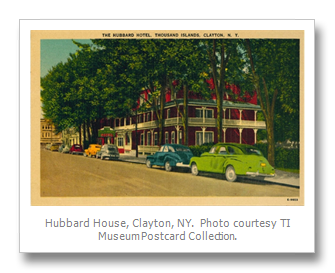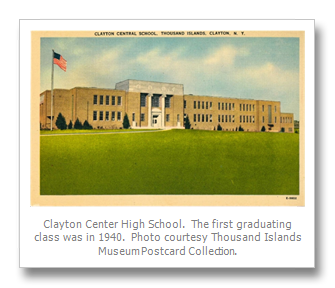It's hard for me to believe that I'm so old that my childhood memories could be called history, but after sitting in on a few sessions of "Hashing Over History" I realize that there's not a lot of the Clayton I knew in the 30s and 40s left. I'll see if I can write a little of it down. Just thinking about it brings back some really precious memories. (and some I'd just as soon forget)

I was born in 1933 on East Line Road. Of course I was born at home. Most babies were then. Dr. Tommy Fowkes helped with the delivery. Maybe at that time he was the only Doctor around here. I really don't know, but I remember him well. He gave all the physicals and eye exams etc at school. He made house calls. If you visited him at his office (over the Ellis Drug Store if my memory serves). He was likely to stop in the middle of an exam and go to the window overlooking the river and watch for 5 minutes or so as an interesting boat or ship or whatever went by, then come back to finish the exam and give the diagnosis. We all depended on him. Later on there was a Dr. Mecklin and Dr Pilpel. My Mother had severe Asthma and heart problems, and those are names that come to mind.

I started school in 1938 which was the last year that school was held in the old red brick School House. If I remember correctly, the jail/fire station was just across the street. We used to sneak over during lunch hour and try to see if anybody was in jail. The next year we moved to the brand new school on Beecher Street. I remember the three big blue school busses that picked up all the students, elementary and High school and made all the necessary bus runs for sports, music and whatever.
A few of the students I started first grade with were still there at graduation, Nancy Blake, whose Father was Frank Blake from Frink Snow Plows, Buddy Good, son of Clifton Good who owned the Chevrolet dealership. Lauraine LeClair, I remember her Father Phileas, who fixed bicycles in later years. There was Mary Margaret Waldron. Her Father, Tommy Waldron, owned Waldron's Jewelry Store. All these businesses are things of the past. Jim Bertrand. Was it the Hubbard house or the Herald House his family owned,.... the big hotel on James street, now the site of Bertrand's motel? I'm a little foggy on these details. I didn't spend much time in the village. As with a lot of families in those days, My Father did the grocery shopping and all the business in town. My Mother and my brothers and sisters stayed mostly on the farm and spent little time in the village.

We didn't have electricity in my early years. I think most people in the village did, and some Farmers, but I remember the kerosene lamps and Lanterns, My Dad carried a lantern to the barn and hung it from a nail in a beam so he and my Mom could see to milk the cows by hand. They milked about 13 cows that way. He carried the lantern up the ladder into the hay mow to pitch the hay down to feed the cows. Just imagine doing that now. He did it and so did all the farmers. It was seldom that a barn burned down from a lantern. It was usually lightning or spontaneous combustion that did it. We had a hand pump on the well. We'd take turns pumping 100 strokes or so until the trough was full and the tank that held the water and ice blocks which cooled the cans of milk was filled.
_3.png)
We pumped water at the well and carried it to the house for the laundry. My Mother heated it on the wood stove and most of my early years I can remember her scrubbing on a wash board. Later on she had a washing machine in the cellar with a wooden handle that she worked back and forth to clean the clothes. There was a wringer on the machine that she turned with a crank to squeeze the water out. Later on it was powered by a gasoline motor. She heated flat irons on the stove to do the ironing. Most of the time she baked her own bread, but when we had store bread she saved the waxed paper wrappers. She used them to wax the bottom of her flat irons so they would glide smoothly and she polished the top of her wood stove by folding the waxed bread wrappers and, using a folded dish towel. she would rub the top of that old wood stove until it shone. Then we got electricity!!!
We had a team of horses, Queenie and Gazer (short for Star Gazer) From the time I was 11 or 12 it was my job to rake the hay with old Gazer, drive the team when we loaded the loose hay on the wagons, and drive whichever horse pulled the rope that drew the forks of hay into the mow. That was how I spent most of my summers. The farm was small. It was all my folks could handle and all they could afford, but I had a very happy childhood there.
Our house was at the top of a hill overlooking the barns and the farm land below. It was flat land and I can remember waking up in the morning to the sound of the train whistle as it crossed Black Creek Road. I could see the smoke trailing from it's stacks clearly from my bedroom window. The trains no longer run to Clayton. That's another thing from the past.
At harvest time the farmers worked together to get the crops in the barns and silos for Winter food. Weather permitting the farmers went from farm to farm to put the oats in the bins and the straw in the barns for bedding. Then the ensilage cutter would follow to chop the corn and fill the silos. They would all bring their teams and wagons to draw the crops from the field to the barns. What a big day it was when the crews came to your farm!! Huge meals, fried chicken or pot roast, always with mashed potatoes and gravy, two or three vegetables all kinds of bread and relishes and pickles and desserts, usually apple pies served with triangular chunks of sharp cheese, or something similar. Each housewife tried to outdo the other and as the men ate up the food the women ate up the compliments. You never wanted to have much left over, and usually there wasn't
As I remember in was John Delaney that owned the machines, at least the ensilage cutter, Now you'll only see these machines which we thought were so huge, rusting in a field somewhere, overgrown with brush. Now that we have Amish in the area, though, you can still see them being put to good use.
My first grade teacher was Betty Streets. She also taught some of our children and even a grandchild or two. When my Grandson, young Steve McAvoy came home from first grade to tell me his teacher was Miss Streets, I told him she had also been my first grade teacher. He looked at me, shocked, and said, "Miss Streets is older than you?" It's always been a family joke, but not one of my "precious memories". I graduated in 1950... could that be 63 years ago? It was a good year for Clayton High School. Our football team was unbeaten, untied and unscored upon. Our band took many prizes at all the area competitions, We thought we were really something!

When I was 12 or 13, I guess, the Bonds moved in next door. The flats would flood after the January thaw, then freeze into one giant skating rink where all the neighborhood kids would skate to their hearts content. Sometimes the ice was rough, and we often had to climb barbed wire fences to get to the best skating, but we had a lot of fun. Leo didn't get as much free time as the rest of us. He was too busy on the farm. It wasn't long though before Leo and I were an "item" and started dating when we were 15. That leads to another phase in the history of Clayton.
We were too young to have our driver's license, but his Dad would let us take his car, a huge old Hudson, and drive to the end of East Line Road. We'd park at Frank and May Hurst's gas station,(where The Dollar Store is now) and walk to Bertrand's Theater, Winter or Summer, hand in hand. The movie, I think, cost twenty five cents, the cokes and the candy bars were a nickle. I'm not sure, because in those days, the boy always paid for everything when you went on a date. At first we went every Saturday night, almost always a Western, later on we went every time the movie changed. (I don't think it was always the movies that interested us. :-). After the movies we'd go to Graves Pharmacy and sit at the soda fountain and have a milk shake or an ice cream soda, then walk back to the car and drive home. None of those things are in Clayton any more.
We filled the car with gas at Art Langto's gas station. (where the Victorian now sits) I don't remember the price of gas, but if you had five dollars you could say "Fill her up" and not have to worry. Mr. Langto also delivered kerosene etc. to the farmers. I can remember everyone being really upset when the price per gallon went from 8 cents up to nine.
Leo worked on his Father's farm. He was out of school when he was 12 years old. In those days they weren't so fussy about how long children went to school. His Father had back trouble and couldn't work the farm alone. There was a big family, and Leo really didn't mind getting out of school. He's regretted it most of his life since then, but at 12 years old he couldn't have cared less.
When he wasn't busy on the farm he earned money working on Leon Reff's hay press. They went around to farms where they had hay to sell. He tells about how a farmer would say "I want to sell the hay in this mow but not that one. They had what they called hay knives, a long curved serrated blade which would saw through the loose hay between the mows. They'd pitch that layer into the press. Someone would have to keep jumping on the hay to pack it into the bales in the press. They made bales from 200 to 250 pounds. Then they'd saw through another layer and bale that until it was all baled. Then at night when they were through Leo and George Bechaz would draw it by the truckload to the depot and roll them onto the railroad cars to be shipped south. (or wherever it as needed)
He worked drawing the blocks of ice and packing it into ice houses for Wallace Kittle. He never cut the ice, but he remembers packing those blocks in sawdust so it wouldn't thaw. Later on they used clean straw which didn't stick to the ice.
After I graduated from school I went to work in E.A. Streets Insurance Agency. I worked 5 days a week and Saturday mornings for $20 a week. After I'd worked a year I got a raise. $25. Wow!
Leo and I were married in 1952 at 18. We worked Carl Reese's farm on Deferno road on shares. When the farm work was done he worked at the GLF feed store (now Christenson's Realty) He and Vernon Burrows and Bob Meeks unloaded tons of feed from the railroad cars, drew them to the feed store where they ground and mixed them, then delivered them to the farmers in the area. He drew hay for his Brother George for a couple of years then we moved to Doug Morrow's farm on DeLafage corners (where the LA Golf course is now) We worked that farm on shares for 5 years, then when the farm was sold we bought the old Dixon farm on Deferno road. (Now it's the House Road)
.png)
That was 1962 and that's when Leo went to work for Gerald Ingerson. He didn't know it, but working for Gerald (which he did for over 40 years years) he was the one that changed the face of Clayton a little at a time. The Mc Carn Farm became Heritage Heights. They built the Causeway to Washington Island which changed things a lot. The old "Frink Field" (maybe my memory is wrong, but isn't that what they called the field where Brook's Drive is now?) became a place for new businesses and housing.
Leo even tore down the old Depot, never thinking that it was a part of history. He says the only thing that bothered him more than tearing down the Depot was tearing down Bombards to make way for Gray's Wholesale.
I don't know when it stops being a couple of years ago..or was it as long as 10 years ago....or was it 20... or is it history. Anyway, I've enjoyed writing it down. If you can separate the facts as I remember them from the mixed up memories of an old lady, maybe you can get something useful out of this nonsense. I hope so, because after reading it over I'm not too sure about any of it.
By Nancy Bond with photography courtesy Sharon Bourquin, Thousand Islands Museum.
Nancy Bond began writing in high school 60+ years ago but then family life took hold as she and her husband Leo raised twelve children on their farm in the town of Clayton. It was only recently that Nancy began writing her memories on paper for her children to enjoy. The Thousand Islands Museum persuaded her to share these memories with the Thousand Islands Sun and now with TI Life for all to enjoy.